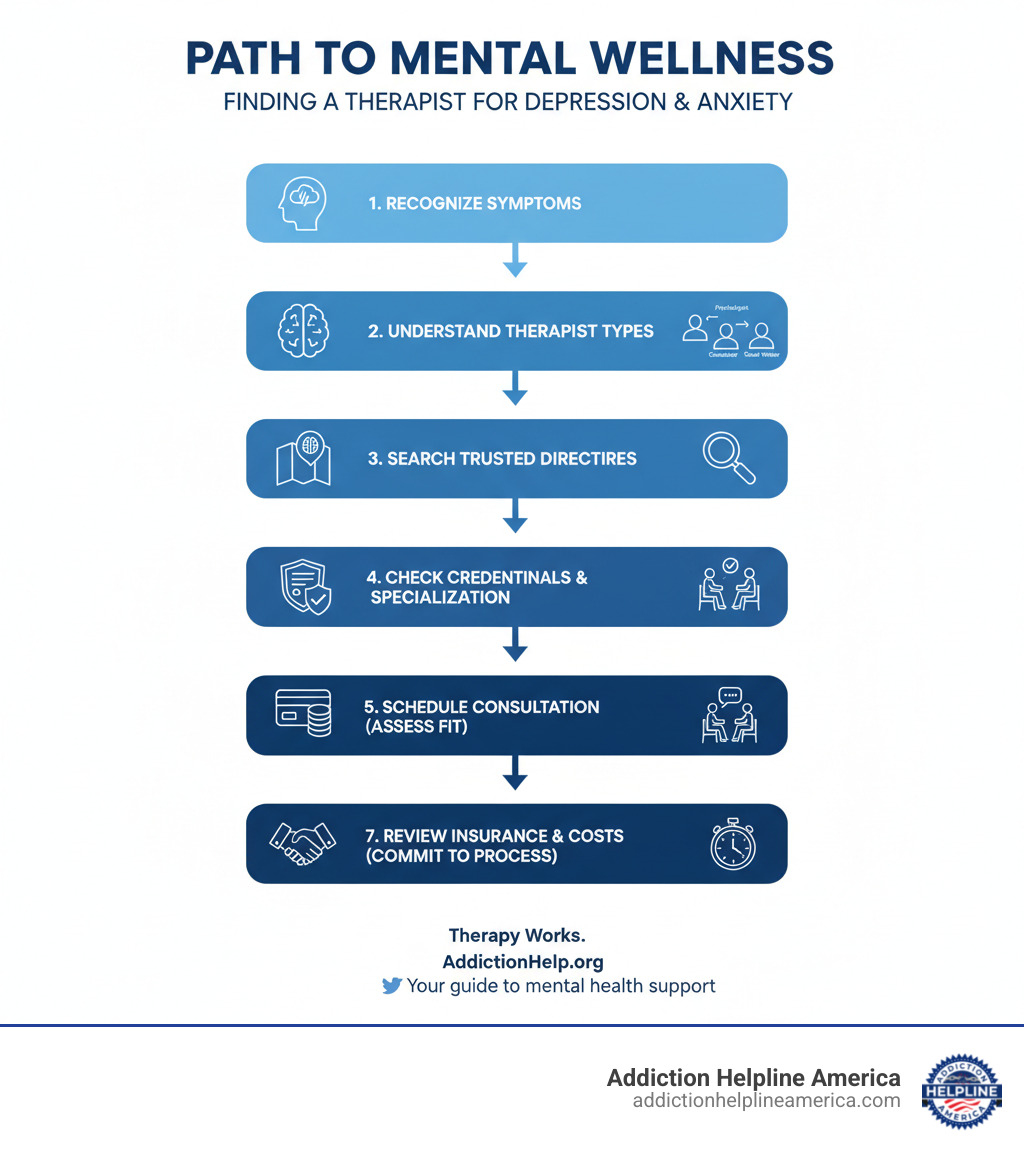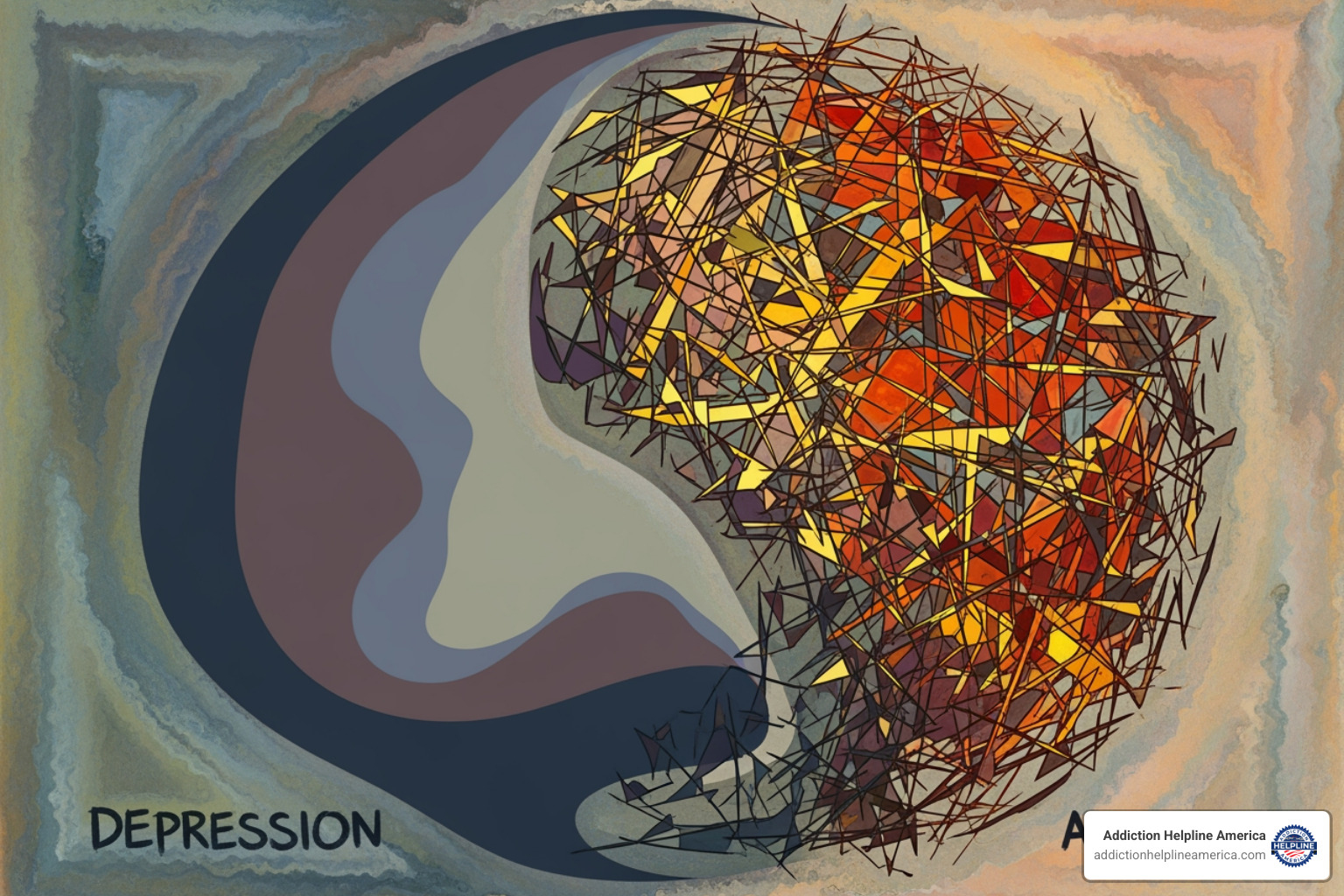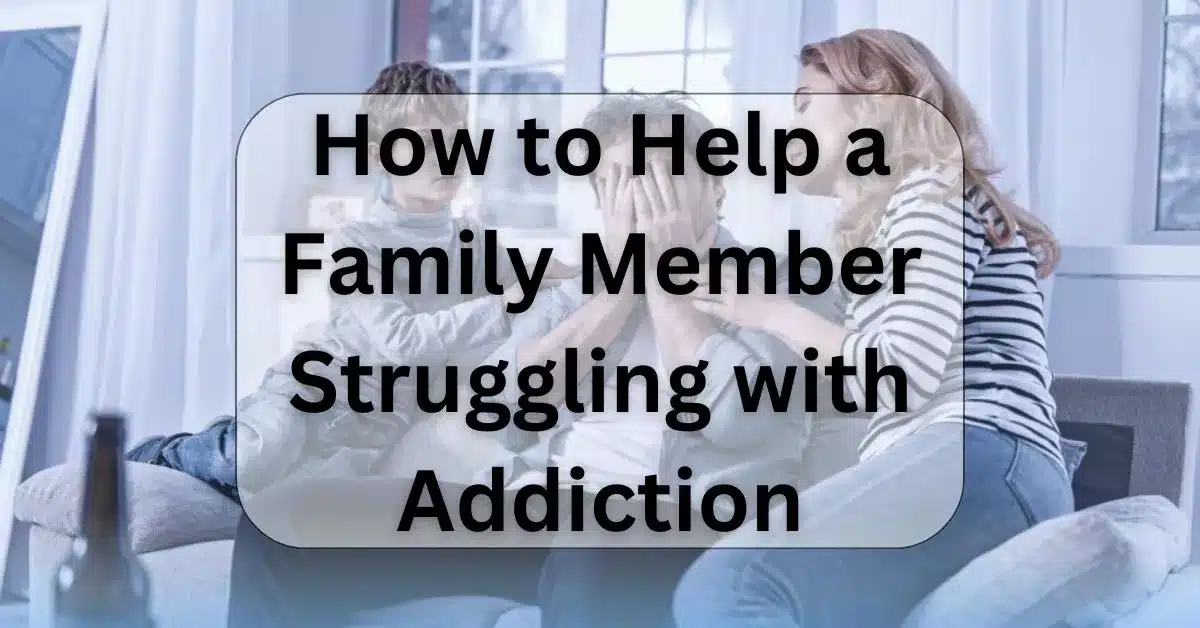
Why Finding the Right Therapist for Depression and Anxiety Matters
A therapist for depression and anxiety can help you through specialized treatment approaches like Cognitive Behavioral Therapy (CBT), which teaches you to challenge negative thoughts and develop healthier coping strategies. The most important factor in successful treatment is finding a therapist you connect with—someone who specializes in your specific concerns and uses evidence-based approaches custom to your needs.
Quick Guide to Finding Your Therapist:
- Identify the type of professional you need – Psychologists, psychiatrists, licensed counselors, and clinical social workers all treat depression and anxiety with different specializations
- Use trusted directories – Search reputable online directories, ask your doctor, or contact your insurance company for referrals
- Check credentials and specialization – Verify they’re licensed and have specific experience treating depression and anxiety
- Schedule initial consultations – Most therapists offer a first meeting to assess fit—use this to ask questions and gauge comfort level
- Consider practical factors – Location, cost, insurance acceptance, online vs. in-person sessions, and availability
Depression and anxiety have become alarmingly common. According to Statistics Canada, the COVID pandemic greatly impacted mental health, with one in five Canadians struggling with depression, anxiety, or other mental health issues. Depression affects one in eight Canadians over their lifespan, and approximately 60% of individuals with anxiety also experience depression.
These aren’t just statistics—they represent real people feeling overwhelmed, stuck, and uncertain where to turn.
The good news? Therapy works. Studies show that therapy is highly effective when patients complete the recommended course of treatment (typically 16 to 20 sessions). Over the long term, therapy proves more effective than medication alone, with more enduring effects. It can reverse the dysfunction in neural circuitry that creates negative thinking patterns and provides coping skills that last a lifetime.
But here’s the challenge: finding the right therapist can feel overwhelming when you’re already struggling. With different types of professionals, therapeutic approaches, insurance considerations, and cost concerns, many people don’t know where to start.
At Addiction Helpline America, we’ve helped thousands of individuals and families steer the path to recovery and mental wellness. Our experienced team specializes in connecting people with appropriate resources for therapist for depression and anxiety treatment, offering compassionate guidance whether you’re seeking help for yourself or a loved one.
This guide breaks down everything you need to know—from understanding your symptoms to choosing the right professional, navigating costs, and accessing free resources.
Similar topics to therapist for depression and anxiety:
- bipolar depression treatment
- can i refuse mental health treatment
- outpatient depression treatment centers near me
Understanding Depression and Anxiety: Signs, Symptoms, and Key Differences
Before you start looking for a therapist for depression and anxiety, it helps to understand what you’re dealing with. Think of it this way: you wouldn’t search for a mechanic without knowing whether your car has engine trouble or transmission issues. The same principle applies here.
Depression and anxiety are two different conditions, though they’re often talked about in the same breath. There’s a good reason for that—they’re frequent companions. About 60% of people with anxiety also experience depression. But they’re not the same thing, and understanding the difference can help you communicate more clearly with potential therapists.
According to the World Health Organization, depression is the leading cause of disability worldwide, affecting over 300 million people. It’s not just feeling sad after a breakup or disappointed when your team loses. Depression is a persistent mood disorder that steals your interest in things you once loved and makes even basic daily tasks feel impossible. Sometimes, it can lead to thoughts of suicide.
Anxiety is your body’s alarm system—and sometimes that alarm gets stuck in the “on” position. It’s normal to feel anxious before a job interview or when facing a genuine threat. But when you’re constantly worried about everything from whether you locked the door to whether people secretly hate you, that’s when anxiety becomes a problem. The National Institute of Mental Health notes that over 30% of people will experience a disabling anxiety disorder at some point in their lives.
So what does this actually look like in everyday life?
With depression, you might notice persistent feelings of sadness, emptiness, or hopelessness that just won’t lift. Activities that used to bring joy—whether that’s seeing friends, playing with your kids, or pursuing hobbies—suddenly feel pointless. Your appetite and weight might change dramatically in either direction. You might sleep too much or barely at all. Everything feels exhausting, even getting out of bed. Feelings of worthlessness or excessive guilt creep in, and making simple decisions becomes surprisingly difficult. In severe cases, recurrent thoughts of death or suicide appear. You might also notice increased irritability or restlessness that seems to come from nowhere.
Anxiety shows up differently. You’re hit with excessive worry or fear about everyday events—things that wouldn’t normally bother you suddenly feel threatening. You feel restless, wound-up, or constantly on edge, like you’re waiting for something bad to happen. Fatigue sets in because anxiety is exhausting, but unlike depression’s heavy tiredness, this comes with a wired, jittery quality. Your mind races or goes completely blank when you need it most. Muscle tension becomes your constant companion, often settling in your shoulders, jaw, or neck. Sleep becomes elusive because your mind won’t quiet down. The physical symptoms can be alarming: rapid heart rate, shortness of breath, sweating, trembling, or stomach upset. You might start avoiding social situations or activities because the fear feels overwhelming.
The Difference Between Depression and Anxiety
While depression and anxiety can feel like they’re ganging up on you, they have distinct personalities. Understanding these differences will help you describe what you’re experiencing to a potential therapist for depression and anxiety.
The core emotional experience differs significantly. Depression’s hallmark is persistent sadness or anhedonia—that’s the clinical term for losing the ability to feel pleasure in things you once enjoyed. Everything feels flat, gray, and pointless. Anxiety’s core is excessive, uncontrollable worry and fear about future events or current situations. Your mind spins out worst-case scenarios constantly.
Energy levels tell different stories too. Depression typically drains your battery completely, leaving you with chronic fatigue that sleep doesn’t fix. Anxiety also exhausts you, but it often manifests as a wired, restless energy—you’re tired but can’t settle down.
Sleep patterns get disrupted by both conditions, but in different ways. Depression might lead you to sleep excessively (hypersomnia) or wake up in the early morning hours unable to fall back asleep. Anxiety usually makes it hard to fall asleep in the first place because your mind won’t stop racing through your worry playlist.
The core emotional state is where the real distinction lies. Depression often brings emotional numbness or overwhelming sadness—you might feel like you’re watching life happen from behind thick glass. Anxiety brings a sense of impending doom, panic, or constant apprehension—like you’re always bracing for impact.
Physical symptoms show up differently too. Both conditions can affect your body, but anxiety often presents with more acute physical responses. Panic attacks come with rapid heartbeat, shortness of breath, and dizziness that can feel like a heart attack. Chronic muscle tension is common. Depression’s physical symptoms tend to be more about heaviness, fatigue, and changes in appetite or sleep.
When to Seek Professional Help
Everyone feels sad sometimes. Everyone worries. That’s part of being human. But there’s a line between normal emotional responses and conditions that need professional attention. Here’s when it’s time to reach out to a therapist for depression and anxiety.
If your symptoms have lasted over two weeks without improvement, that’s a clear signal. Temporary sadness or worry is normal; persistent feelings that don’t respond to positive changes in your life are not.
When your symptoms impact your daily functioning, it’s time to get help. This means your work performance is suffering, your relationships are strained, you’re missing school, or you’ve stopped doing activities you need or used to enjoy. If getting through a normal day feels like climbing Everest, don’t wait.
Suicidal thoughts require immediate action. If you’re thinking about harming yourself, call or text 988 for the Suicide & Crisis Lifeline right away. This is always an emergency, no exceptions.
If you’re experiencing an inability to cope with daily stressors—when everyday tasks or unexpected challenges feel impossible—professional support can make a tremendous difference.
Here’s the truth: seeking help is a sign of strength, not weakness. It takes courage to admit you’re struggling and reach out. A qualified professional can provide strategies and support to help you steer these challenging emotions. At Addiction Helpline America, we’re here to help connect you with the right resources, whether you’re seeking help for yourself or someone you care about.
The Power of Therapy: Types, Effectiveness, and Benefits
Therapy, also known as psychotherapy or counseling, is a highly effective treatment for both depression and anxiety. It provides a safe, confidential space to explore thoughts, feelings, and behaviors with a trained professional. Many studies show that therapy is highly effective, provided patients complete the prescribed course, commonly 16 to 20 sessions.
The benefits of therapy extend far beyond symptom reduction:
- Long-term benefits: Therapy’s effects are often more enduring than medication, empowering you with coping techniques and problem-solving skills that last a lifetime.
- Relapse prevention: Therapy helps you understand the root causes of your depression and anxiety, developing strategies to prevent future relapses. Most depression treatment programs include relapse prevention planning and aftercare.
- Relieving mental pain: Therapy aims to alleviate the mental anguish that distorts thinking and feeling, helping you see beyond your current state and envision a better future.
- Regaining motivation and pleasure: By challenging negative thought patterns and learning new behaviors, therapy helps restore your capacity for pleasure and motivation.
- Reversing neural dysfunction: Psychotherapy can reverse the dysfunction in neural circuitry that predisposes individuals to a negative view of themselves, the world, and their future.
Common Types of Therapy for Depression and Anxiety
There isn’t a one-size-fits-all approach to therapy. A good therapist for depression and anxiety will tailor their approach to your unique needs. Here are some of the most common and effective types:
- Cognitive Behavioral Therapy (CBT): This is one of the most widely used and effective therapies for both depression and anxiety. It focuses on identifying and changing negative thought patterns and behaviors.
- Interpersonal Therapy (IPT): IPT focuses on improving interpersonal relationships and social functioning, as these issues can often contribute to or be exacerbated by depression.
- Psychodynamic Therapy: This approach explores how past experiences and unconscious patterns influence current feelings and behaviors, aiming for deeper insight and resolution.
- Somatic Therapy: Somatic therapies focus on the connection between the mind and body, using physical techniques to release trauma and emotional stress stored in the body.
- Mindfulness-Based Approaches: These therapies (like Mindfulness-Based Cognitive Therapy, MBCT) teach techniques to increase awareness and acceptance of thoughts and feelings without judgment, helping to reduce rumination and worry.
A Closer Look at Cognitive Behavioral Therapy (CBT)
CBT is a powerhouse in mental health treatment, particularly for depression and anxiety. The National Institute of Mental Health (NIMH) recognizes psychotherapies like CBT as effective treatments.
How CBT works:
CBT operates on the principle that our thoughts, feelings, and behaviors are interconnected. By changing one, we can influence the others.
- Identifying negative thought patterns: A CBT therapist for depression and anxiety helps you recognize distorted or unhelpful thought patterns (e.g., catastrophizing, all-or-nothing thinking) that contribute to your distress.
- Behavioral strategies: You’ll learn and practice new behaviors. For example, behavioral activation (often used with CBT) encourages engagement in rewarding activities to counteract the inertia of depression.
- Challenging beliefs: The therapist guides you in questioning the validity and usefulness of your negative thoughts and beliefs, helping you develop more balanced and realistic perspectives.
- Curbing reactivity: CBT teaches techniques to manage your emotional responses to distressing situations, giving you more control over your feelings rather than being overwhelmed by them.
Through “homework” assignments, you’ll practice these skills between sessions, solidifying new ways of thinking and behaving.
Your Practical Guide to Finding a Therapist for Depression and Anxiety
Finding the right therapist for depression and anxiety is a crucial step toward healing. It’s not just about finding a therapist, but the right therapist—someone with whom you feel comfortable, understood, and challenged in a supportive way. The quality of the therapeutic relationship is often cited as the most important factor in successful therapy outcomes.
Whether you’re looking for online therapy (which studies have found highly effective, offering accessibility and convenience) or in-person sessions, there are many avenues to explore.
Step 1: Know the Different Types of Mental Health Professionals
The mental health field has various professionals, each with different training, specializations, and scopes of practice. Understanding these differences can help you determine who might be the best fit for your needs.
| Professional Type | Education & Training | Ability to Prescribe Medication | Typical Focus |
|---|---|---|---|
| Psychologist | Doctoral degree (Ph.D., Psy.D.) | No (in most states) | Psychotherapy, psychological testing, and diagnosis. |
| Psychiatrist | Medical degree (M.D. or D.O.) | Yes | Diagnosis, medication management, and some psychotherapy. |
| Registered Psychotherapist/Counselor (e.g., LPC, LMHC) | Master’s degree (M.A., M.S.) | No | Counseling and psychotherapy for various mental health issues. |
| Clinical Social Worker (e.g., LCSW, LICSW) | Master’s degree in Social Work (MSW) | No | Psychotherapy, case management, and advocacy, with a focus on social and environmental factors. |
Step 2: How to Find a Therapist for Depression and Anxiety
- Use trusted online directories: Websites like Psychology Today, the American Psychological Association, and the National Board for Certified Counselors offer searchable databases of licensed professionals.
- Ask your primary care physician: Your doctor can often provide a referral to a trusted mental health professional in your area.
- Check with your insurance company: Your insurance provider can give you a list of in-network therapists, which can significantly reduce costs.
- Contact Addiction Helpline America: Our team can provide confidential, personalized guidance to help you find the right therapist or treatment program from our vetted network.
Step 3: What to Consider When Choosing a Therapist for Depression and Anxiety
- Credentials and Licensing: Ensure the therapist is licensed to practice in your state. This confirms they have met the required education and training standards.
- Specialization: Look for a professional who has specific experience and training in treating depression and anxiety. Ask about their experience with evidence-based practices like CBT.
- Therapeutic Approach: Does their approach (e.g., CBT, psychodynamic, somatic) resonate with you? A good therapist will explain their methods and how they can help your specific situation.
- Initial Consultation: Most therapists offer a free 15-20 minute consultation. Use this time to ask questions, describe your concerns, and see if you feel a connection.
- Personality Fit: Do you feel comfortable and safe talking to this person? Trust your gut. A strong therapeutic alliance is key to success. For more guidance, see our tips for choosing a therapist.
Our helpline is 100%
free & confidential
If you or someone you care about is struggling with drug or alcohol addiction, we can help you explore your recovery options. Don’t face this challenge alone—seek support from us.
Programs
Resources
Will my insurance
cover addiction
treatment?
We're ready to help
Find the best
drug or alcohol treatment
center
Are you or a loved one struggling with addiction? Call today to speak to a treatment expert.















